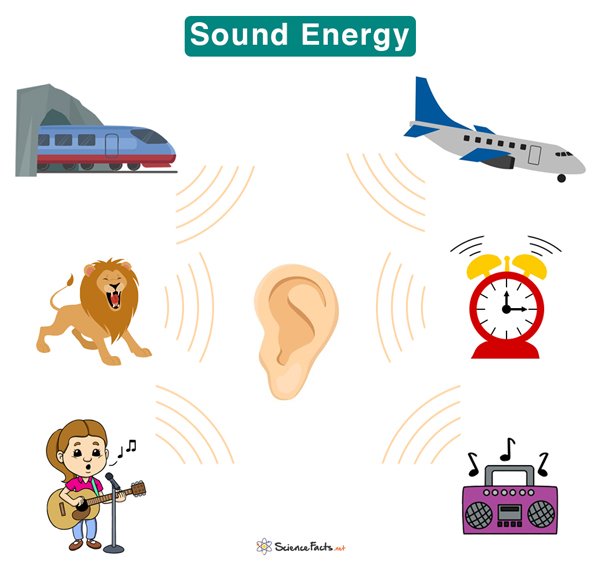Sound Energy
Sound energy is a form of kinetic energy caused by the physical vibration of air particles or molecules. The particles collide with other neighboring particles causing them to vibrate. These vibrations travel in a straight line. When they reach our ears, we perceive them as sound.
Examples
Sound energy is derived from an external source. Here are some examples of how sound is generated.
- Car honking
- Airplane taking off
- Police whistling
- Dog barking
- Wind howling
- Baby crying
How does Sound Energy Work
The particles vibrate about their position until they reach an equilibrium. The vibrations, and hence sound, are transmitted in the form of a wave, known as a sound wave. The particles vibrate in the same direction as the wave propagates. Such type of wave is known as a longitudinal wave. The sound wave carries energy and keeps traveling until it loses energy.
Sound requires a medium to propagate. It can travel through air, water, wood, glass, or metal. Unlike light, sound cannot propagate in a vacuum since there are no particles to transmit the wave.
How does Sound Wave Transfer Energy to Your Ears
When sound waves reach our ears, they are funneled to the eardrum. The eardrum is a part of the ear that converts sound energy into mechanical movements. It vibrates when struck, and a fluid carries the vibrations through three connected bones. The moving fluid bends a series of hair-like cells that convert the vibrations into nerve impulses. These impulses are carried to the brain by auditory nerves. The brain interprets them as sound.
How is Sound Energy Measured
The intensity of sound is measured in the unit of decibels or dB, named after Scottish-born inventor Alexander Graham Bell. Bell invented the audiometer, a device that measures how well a person can hear sound. The decibel scale is logarithmic, which means that it represents the ratio of two measurable physical quantities. Similarly, sound pressure can also be expressed in dB. For example, a normal speaking voice is 60 dB. The sound of an airplane taking off is 115 dB.
Sound wave frequency is measured in the unit of Hertz or Hz. One Hertz is equal to one sound vibration in one second. For a human to hear the sound, the frequency must be between 20 and 20,000 Hz. Any frequency below 20 Hz is called infrasound; above 20,000 Hz is called ultrasound. These two types of sound are inaudible to the human ear.
Conversion of Sound Energy
From the energy conservation law, energy can neither be created nor destroyed. It can be transferred from one form to another. Here are some examples of how sound energy can be converted into other forms and vice versa.
- A microphone converts sound energy to electrical energy
- A loudspeaker converts electrical energy into sound energy
- A drummer converts mechanical energy into sound energy
- An electric bell converts electrical energy into sound energy
Uses
The primary use of sound energy is for hearing. Aside, it has other applications.
- Scientists use infrasonic sound to predict an earthquake, volcano, and avalanche
- A particular type of sound, SONAR (Sound Navigation And Ranging), is used to map the ocean floor
- Doctors use ultrasound to cure tumor cells of a cancer patient without any physical pain
- Doctors also use ultrasound on pregnant women to detect any abnormality in the fetus
- Ultrasound is used in the industry to detect any flaws in machinery parts and to determine the thickness of metal
- Soothing musical sound from Tibetian bowls can remove stress and body pain
- Bats produce ultrasonic waves to communicate among themselves and to find obstacles in their path
-
References
Article was last reviewed on Thursday, July 28, 2022









May l download it?
Yes, you can cite our article if you decide to refer it.
don’t think they need it anymore
Thanks ???? for sund je vous remercie de votre réponse.